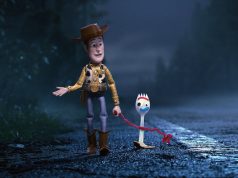Here’s what clout can get you: If anyone other than Robert Zemeckis and Tom Hanks were involved in making a film version of “The Polar Express,” no one would suspect for a minute that it would be any good. The children’s book it’s based on is something like 30 pages long — far too short to be adapted into a feature — and it has no story to speak of. (Boy doubts Santa Claus; boy gets on magic train that takes him to North Pole on Christmas Eve; boy believes.) If anyone else were doing this, you’d hear about it and say, “A movie version of ‘The Polar Express’? Computer-animated? Wow, that’s gonna suck.”
But since it’s Zemeckis and Hanks, we take notice. We give them the benefit of the doubt. We know it’s rare for either of them to make a truly BAD movie, and their joint efforts (“Forrest Gump” and “Cast Away”) were outstanding. So, like a skeptical kid caught up in the magic of Christmas Eve, we start to believe. “Maybe this movie is gonna be OK after all,” we think. “Maybe….”
And then, like the same kid sneaking downstairs to find Dad eating the cookies left out for Santa, we realize we were fools to ever believe that such a thing was possible. Screw you, Tom Hanks! Screw you, Robert Zemeckis! You made a dull, un-magical film!
Zemeckis, a special-effects guy from way back, had his team create new technology just to make a mediocre movie. The film is computer-animated, in a sense, with real actors’ motions being captured digitally and converted into animation. The result is that everything looks very realistic, as long as it stands still. Once it starts moving — and this applies to people, trains and animals — it looks fake and mechanical. People’s faces look especially creepy, like robots trying to approximate human behavior.
It’s hard to identify with characters who seem alien, and that problem is exacerbated by a screenplay that gives them nothing to do. Adapted from Chris Van Allsburg’s picture book by Zemeckis and frequent collaborator William Broyles Jr., the film stays true to the book without adding a lot of subplots or diversions. I admire the faithfulness, I suppose, but let’s remember: The book has about five minutes’ worth of text. The movie merely stretches it out. So now, where the book might simply say, “And Santa flew off into the night,” we have a spectacular visual of Santa flying off into the night … and it lasts for two minutes.
Our hero, whose name we do not learn, is a young boy whose belief in Santa Claus is beginning to wane. On Christmas Eve, a magical train pulls up outside his house and the conductor (Tom Hanks, who is also the narrator and a few other characters) invites him aboard. Where’s the train going? “Why, the North Pole, of course!” is the wonderfully Hanks-ian reply.
On the train, Hero Boy meets Lonely Boy (Peter Scolari), Hero Girl (Nona Gaye) and Know-It-All (Eddie Deezen), all fellow travelers on this crazy journey, presumably all Santa-doubters, too. As the train chugs northward, Hero Boy and friends get into a variety of train-related adventures: losing tickets, falling out windows, skidding across ice, encountering large herds of caribou, that sort of thing, all of it rendered grandly and beautifully and without any heart whatsoever.
There are also a couple musical numbers, including the singularly generic pop tune “When Christmas Comes to Town,” plaintively sung by Hero Girl and Lonely Boy (well, by two singers the producers brought in to sing for them) in a manner suggesting someone really, really wants the song to be nominated for an Oscar.
But then there is Tom Hanks. I caught “Saturday Night Live’s” “Best of Tom Hanks” rerun last week, and it occurred to me exactly why he’s so popular: enthusiasm. He committed to every character in every sketch in that show with abandon — not reckless abandon, but confident, skillful, cheerful abandon. Yeah, yeah, there’s the Method Acting stuff like gaining and losing all that weight for “Cast Away”; obviously that takes dedication. But the dedication that audiences really respond to is the commitment an actor makes IN THE MOMENT, on the screen. When Hanks plays a role — and he plays several in “The Polar Express” — he doesn’t just phone it in. He gives it the full weight of his intelligence, energy and talent. You just enjoy watching him.
Which is another reason “The Polar Express” doesn’t quite work: The stilted animation can’t keep up with Hanks’ effervescence. The Pixar folks managed it in the “Toy Story” films, but here the medium is too weighty to match the buoyancy in Hanks’ performances. Besides, all the vivacity in the world can’t help a movie that has no story.
C- (1 hr., 38 min.; )





